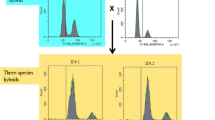Summary
-
1.
The somatic chromosomes ofAesculus Hippocastanum (2n = 40) and ofAe. Pavia (2n = 40) are exactly similar in size and shape, although each complement contains within it differences which are also distinguishable in the complement of the hybridAe. carnea (2n = 80).
-
2.
In both species, and in the hybrid, polar views of metaphase I show about half the bivalents larger than the rest, and this is due to their having chiasmata in both arms. This difference necessarily disappears at anaphase.
-
3.
Secondary pairing and the formation of an occasional quadrivalent show the parent species to be tetraploid. The hybrid must therefore be regarded as octoploid.
-
3a.
4.Ae. planlierensis (2n = 60) is a hexaploid back-cross ofAe. carnea Ae. Hippocastanum, and forms varying numbers of multivalents, bivalents and univalents.
-
5.
The individuals ofAe. Hippocastanum andAe. carnea examined are heterozygous for inversions.
Similar content being viewed by others

References
Bean, W. T. (1914).Trees and Shrubs Hardy in the British Isles, 1. London.
Crane, M. B. (1936). “Note on a periclinal chimaera in the potato.”J. Genet. 32, 73–7.
Darlington, C. D. (1928). “Studies inPrimus. I and II.”Ibid. 19, 213–56.
—— (1929 a). “A comparative study of the chromosome complement inRibes.”Genelica,11, 267–72.
—— (1929 b). “Chromosome behaviour and structural hybridity in theTradescantiae.”J. Genet. 21, 207–86.
—— (1932 a). “The control of the chromosomes by the genotype and its bearing on some evolutionary problems.”Amer. Nat. 66, 25–51.
Darlington, C. D. (1932b).Recent Advances in Cytology. London.
—— (1935). “Crossing-over and chromosome disjunction.”Nature, Land.,136, 835.
Ellison, W. (1935). “Certain British varieties of the common cultivated potato.”Genelica,17, 1–26.
Farmer, J. B. andDigby, L. (1914). “On the dimensions of chromosomes considered in relation to phylogeuy.”Philos. Trans. B,205, 1–25.
Geitler, L. (1932). “Das Verhalten der Nucleolen in einer tetraploiden Wurzel vonCrepis capillaris.”Planta,17, S01–4.
Hoar, C. S. (1927). “Chromosome studies inAesculus.”Bot. Gaz. 84, 156–70.
Kihara, H. (1929). “Conjugation of homologous chromosomes in genus hybridsTrilicum-Aegilops and species hybrids ofAegilops.”Cylologia,1, 1–15.
La Cour, L. (1931). “Improvements in everyday technique in plant cytology.”J.R. micr. Soc. 51, 119–26.
Manton, I. (1935). “Some new evidence on the physical nature of plant nuclei from interspecific polyploids.”Proc. roy. Soc. B,118, 522–47.
Mol, W. E.:de (1928). “Nucleolar size in diploid, triploid and aneuploid hyacinths.”Cellule,38, 1–65.
Navashin, M. S. (1931). “Chromatic mass and cell volume in related species.”Univ. Gal. Pub. Agr. Sci. 6, 207–30.
Newton, W. C. F. andPellew, C. (1929). “Primula Icewensis and its derivatives.”J. Genet. 22, 1–14.
Skovsted, A. (1929). “Cytological investigation of the genusAesculus L.”Heredilas,11, 64–70.
—— (1935). “Cytological studies in cotton. III. A hybrid betweenGossypium Davidsonii Kell. andG. Slurlii F. Muell.”J. Genet. 30, 397–405.
Tischler, G. (1927). “Chromosomenstudien beiRibes Gordonianum und seinen Eltern.”Planla,4, 617–50.
Author information
Authors and Affiliations
Rights and permissions
About this article
Cite this article
Upcott, M. The parents and progeny of aesculus carnea. Journ. of Genetics 33, 135–149 (1936). https://doi.org/10.1007/BF03027607
Issue Date:
DOI: https://doi.org/10.1007/BF03027607



